
Radio broadcasting is the broadcasting of audio (sound), sometimes with related metadata, by radio waves to radio receivers belonging to a public audience. In terrestrial radio broadcasting the radio waves are broadcast by a land-based radio station, while in satellite radio the radio waves are broadcast by a satellite in Earth orbit. To receive the content the listener must have a broadcast radio receiver (radio). Stations are often affiliated with a radio network that provides content in a common radio format, either in broadcast syndication or simulcast, or both. Radio stations broadcast with several different types of modulation: AM radio stations transmit in AM, FM radio stations transmit in FM, which are older analog audio standards, while newer digital radio stations transmit in several digital audio standards: DAB, HD radio, DRM. Television broadcasting is a separate service that also uses radio frequencies to broadcast television (video) signals.

Digital Radio Mondiale is a set of digital audio broadcasting technologies designed to work over the bands currently used for analogue radio broadcasting including AM broadcasting—particularly shortwave—and FM broadcasting. DRM is more spectrally efficient than AM and FM, allowing more stations, at higher quality, into a given amount of bandwidth, using xHE-AAC audio coding format. Various other MPEG-4 codecs and Opus are also compatible, but the standard now specifies xHE-AAC.
Digital radio is the use of digital technology to transmit or receive across the radio spectrum. Digital transmission by radio waves includes digital broadcasting, and especially digital audio radio services.

BBC Radio Oxford is the BBC's local radio station serving the county of Oxfordshire.
BBC Radio Northampton is the BBC's local radio station serving the county of Northamptonshire.

BBC Radio Solent is the BBC's local radio station serving Hampshire, Dorset and the Isle of Wight, broadcasting on FM, DAB, digital TV and via BBC Sounds from studios on Havelock Road in Southampton.

BBC Radio Devon is the BBC's local radio station serving the county of Devon.

BBC Radio Leeds is the BBC's local radio station serving the county of West Yorkshire.

BBC Radio Sheffield is the BBC's local radio station serving South Yorkshire and north Derbyshire.

BBC Radio Cumbria is the BBC's local radio station serving the county of Cumbria.
Greatest Hits Radio South Wales is an Independent Local Radio station owned and operated by Bauer Radio as part of the Greatest Hits Radio network. The station broadcasts to Swansea, Cardiff, Newport and surrounding areas from studios in the Gowerton area of Swansea on DAB.

BBC Radio Ulster is a Northern Irish national radio station owned and operated by BBC Northern Ireland, a division of the BBC. It was established on New Year's Day 1975, replacing what had been an opt-out of BBC Radio 4.
MFR is an Independent Local Radio station based in Inverness, owned and operated by Bauer as part of the Hits Radio Network. It broadcasts to Moray and the Inverness area. Previously, it broadcast to the Scottish Highlands and South West Aberdeenshire, but this ceased on 11th December 2023 when the 1107 kHZ AM transmitter at Tarbet Ness was switched off.

FM broadcasting is a method of radio broadcasting that uses frequency modulation (FM) of the radio broadcast carrier wave. Invented in 1933 by American engineer Edwin Armstrong, wide-band FM is used worldwide to transmit high-fidelity sound over broadcast radio. FM broadcasting offers higher fidelity—more accurate reproduction of the original program sound—than other broadcasting techniques, such as AM broadcasting. It is also less susceptible to common forms of interference, having less static and popping sounds than are often heard on AM. Therefore, FM is used for most broadcasts of music and general audio. FM radio stations use the very high frequency range of radio frequencies.

Manx Radio is the national commercial radio station for the Isle of Man. It began broadcasting on 29 June 1964, almost ten years before legal commercial radio was licensed in the United Kingdom. The Isle of Man, having its own government and laws, was not subject to the rules prohibiting commercial broadcasting in the UK. However, the Manx Government still had to apply to the UK's General Post Office for a frequency and for permission to broadcast. First requested in 1960, a licence was eventually granted in May 1964. It was allocated an FM frequency of 89.0 MHz and a comparatively low power of 50 watts. In October 1964, an additional frequency of 1594 kHz AM was allocated to the station to provide greater coverage, although again at a limited power of 50 watts. It broadcasts primarily in English with several hours per week of Manx language programming.
Independent National Radio (INR) is the official term for the three national commercial radio stations currently or previously broadcasting on analogue radio in the United Kingdom. The two stations currently or previously broadcasting on AM were allocated frequencies previously used by BBC Radio 3 and BBC Radio 1.
FM sound broadcasting began in the United Kingdom on 2 May 1955 when the BBC started an FM broadcasting service the Light Programme, the Third Programme and the Home Service to the south east of England. There are now over 40 BBC and over 250 commercial FM sound broadcasting stations in the United Kingdom.

In the United Kingdom, the roll-out of digital radio has been proceeding since engineering test transmissions were started by the BBC in 1990 followed by a public launch in September 1995. The UK currently has one of the world's biggest digital radio networks, with about 500 transmitters, three national DAB ensembles, one regional DAB ensemble, 48 local DAB ensembles and an increasing number of small-scale DAB ensembles broadcasting over 250 commercial and 34 BBC radio stations across the UK. In London there are already more than 100 different digital stations available. In addition to DAB and DAB+, radio stations are also broadcast on digital television platform as well as internet radio in the UK. Digital radio ensemble operators and stations need a broadcasting licence from the UK's media regulator Ofcom to broadcast.

JACK FM was an adult hits format radio station that broadcast on 106.8 MHz FM in Oxford, Oxfordshire, United Kingdom, and on DAB in Oxfordshire. Between 2016 and 2017 it also broadcast in Surrey and parts of Hampshire. The station shared premises in Eynsham, Oxfordshire, with its sister stations JACK 2 and JACK 3.












